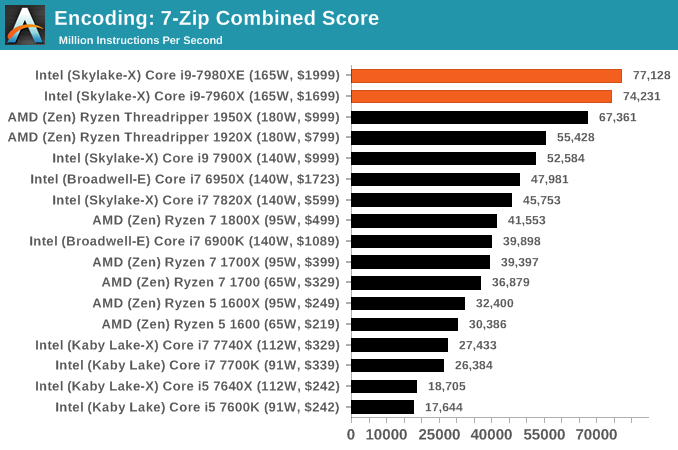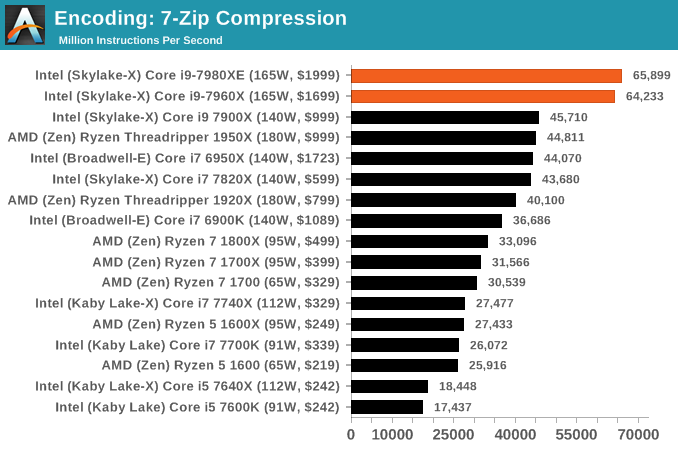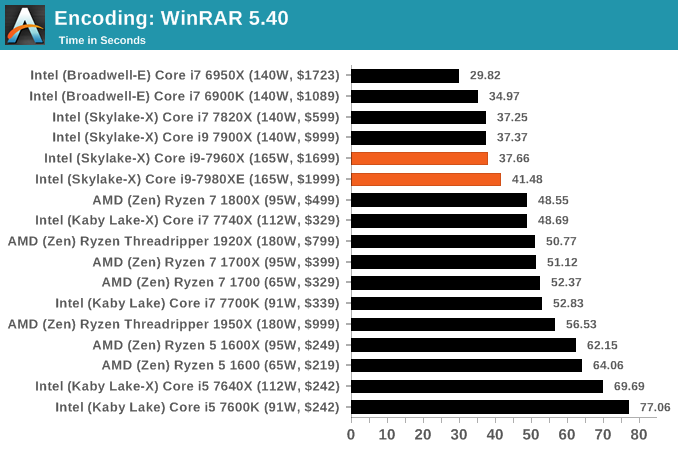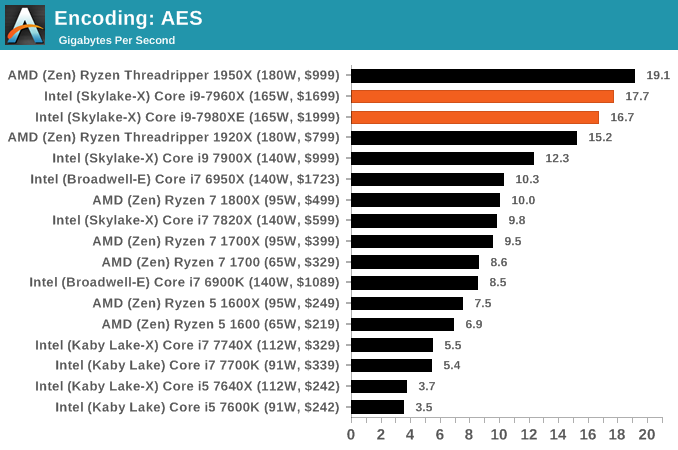The Intel Core i9-7980XE and Core i9-7960X CPU Review Part 1: Workstation
by Ian Cutress on September 25, 2017 3:01 AM ESTBenchmarking Performance: CPU Encoding Tests
One of the interesting elements on modern processors is encoding performance. This includes encryption/decryption, as well as video transcoding from one video format to another. In the encrypt/decrypt scenario, this remains pertinent to on-the-fly encryption of sensitive data - a process by which more modern devices are leaning to for software security. Video transcoding as a tool to adjust the quality, file size and resolution of a video file has boomed in recent years, such as providing the optimum video for devices before consumption, or for game streamers who are wanting to upload the output from their video camera in real-time. As we move into live 3D video, this task will only get more strenuous, and it turns out that the performance of certain algorithms is a function of the input/output of the content.
All of our benchmark results can also be found in our benchmark engine, Bench.
7-Zip 9.2: link
One of the freeware compression tools that offers good scaling performance between processors is 7-Zip. It runs under an open-source licence, is fast, and easy to use tool for power users. We run the benchmark mode via the command line for four loops and take the output score.



WinRAR 5.40: link
For the 2017 test suite, we move to the latest version of WinRAR in our compression test. WinRAR in some quarters is more user friendly that 7-Zip, hence its inclusion. Rather than use a benchmark mode as we did with 7-Zip, here we take a set of files representative of a generic stack (33 video files in 1.37 GB, 2834 smaller website files in 370 folders in 150 MB) of compressible and incompressible formats. The results shown are the time taken to encode the file. Due to DRAM caching, we run the test 10 times and take the average of the last five runs when the benchmark is in a steady state.

AES Encoding
Algorithms using AES coding have spread far and wide as a ubiquitous tool for encryption. Again, this is another CPU limited test, and modern CPUs have special AES pathways to accelerate their performance. We often see scaling in both frequency and cores with this benchmark. We use the latest version of TrueCrypt and run its benchmark mode over 1GB of in-DRAM data. Results shown are the GB/s average of encryption and decryption.

HandBrake v1.0.2 H264 and HEVC: link
As mentioned above, video transcoding (both encode and decode) is a hot topic in performance metrics as more and more content is being created. First consideration is the standard in which the video is encoded, which can be lossless or lossy, trade performance for file-size, trade quality for file-size, or all of the above can increase encoding rates to help accelerate decoding rates. Alongside Google's favorite codec, VP9, there are two others that are taking hold: H264, the older codec, is practically everywhere and is designed to be optimized for 1080p video, and HEVC (or H265) that is aimed to provide the same quality as H264 but at a lower file-size (or better quality for the same size). HEVC is important as 4K is streamed over the air, meaning less bits need to be transferred for the same quality content.
Handbrake is a favored tool for transcoding, and so our test regime takes care of three areas.
Low Quality/Resolution H264: Here we transcode a 640x266 H264 rip of a 2 hour film, and change the encoding from Main profile to High profile, using the very-fast preset.

High Quality/Resolution H264: A similar test, but this time we take a ten-minute double 4K (3840x4320) file running at 60 Hz and transcode from Main to High, using the very-fast preset.

HEVC Test: Using the same video in HQ, we change the resolution and codec of the original video from 4K60 in H264 into 4K60 HEVC.











152 Comments
View All Comments
Gothmoth - Monday, September 25, 2017 - link
well i did not notice as much bias and other stuff when anand was still here.Spunjji - Monday, September 25, 2017 - link
Seriously..? Ever read any of the Apple product reviews? :Dandrewaggb - Monday, September 25, 2017 - link
lol, I was going to say that too. Anand had (in my opinion) a clear apple bias at the end and then went to work for them. That's not to say apple wasn't making good products or not doing interesting things - they were one of the few tech companies doing anything interesting.Notmyusualid - Tuesday, September 26, 2017 - link
+1tipoo - Tuesday, September 26, 2017 - link
I mean, imo he was pretty fair about them, he liked them and didn't say they were utter garbage because they tend not to make utter garbage. He did point out flaws fairly.flyingpants1 - Tuesday, September 26, 2017 - link
Yes that is the general consensus around here.Some of the podcasts with Anand and Brian Klug were embarrassing, they had a third guy but they would just talk over him. Brian was this really obnoxious guy who made fun of people who want removable batteries and microSD cards, he said "You got what you got!"
lmao... industry shills.. wants to save the companies 10 cents for a microSD slot, and force people to overpay for 12GB space plus data usage.. How are you supposed to shoot 4k video and keep a movie/TV database with that. 128gb microSD card is perfect. Meanwhile they add ridiculous nonsense like taptic engine and face scanning instead of making the battery a bit thicker
FreckledTrout - Monday, September 25, 2017 - link
I do because they know a disproportionate amount of their user base is tech savvy and run ad blockers with one click will en mass black block adds. Keep the adds clean and we leave the blockers off....we help each other but it is a give and take.damianrobertjones - Saturday, September 30, 2017 - link
Did you know that capitals can be your friend!ddriver - Monday, September 25, 2017 - link
Workstation without ECC... that's a bad joke right there. Or at best, some very casual workstation. But hey, if you like losing data, time and money - be my guest. Twice the memory channels, and usually all dims would be populated in a workstation scenario, that's plenty of ram to get faulty and ruin tons of potentially important data.Also, what ads? Haven't you heard of uBlock :)
"Explaining the Jump to Using HCC Silicon" - basically the only way for intel to avoid embarrassment. Which they did in a truly embarrassing way - by gutting the ECC support out of silicon that already has it.
AVX512 - all good, but it will take a lot of time before software catches up. Kudos to intel for doing the early pioneering for once.
At that price - thanks but no thanks. At that price point, you might as well skip TR and go EPYC. Performance advantages, where intel has them, are hardly worth the price premium. You also get more IO on top of not supporting a vile, greedy, anticompetitive monopoly that has held progress back for decades so it can milk it. But hey, as AT seems to hint it, you have got to buy intel not to be considered a poor peasant who can't afford it. I guess being dumb enough to not value your money is a good thing if it sends your money in intel's pocket.
nowayandnohow - Monday, September 25, 2017 - link
"Haven't you heard of uBlock :)"Haven't you heard that this site isn't free to run, and some of us support anandtech by letting them display ads?